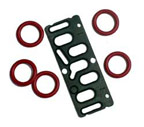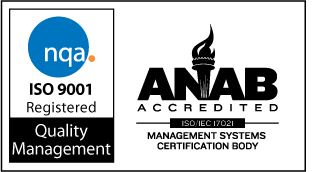
|
7108
S. Alton Way, Unit I |
(303) 758-2728
Home > O-ring, Seal Design > Vacuums
Sealing in a Vacuum
|
Approximately 25% of the process steps in semiconductor fabrication require vacuum processes. A vacuum is a space from which all air and other gases have been removed. It is not possible to remove all the gases. The importance of vacuum lies mainly on the molecular level. Higher vacuums allow longer paths for molecules to take without colliding or reacting with other molecules or other surfaces.
Low vacuum is from atmospheric pressure (105 Pa) to 0.1 Pa (1 mTorr). The gas dynamics are characterized by viscous flow-the collisions between gas molecules. This pressure range is used for processes such as sputtering that depend on gas-phase chemical reactions and momentum transfer between molecules.
High vacuum is characterized by molecular flow-minimal collisions between gas molecules, and some collisions with chamber walls. The lowest pressure that can be reached with an unbaked system is 10-6 Pa (10-8 Torr). Ultra-high vacuum is again characterized by molecular flow. Elastomers are virtually non-existent with the lower pressure limit determined by hydrogen diffusing through metal walls.
Achieving Vacuum Levels
Rotary vane, piston and sorption pumps have a low-pressure limit of 10-1 to 10-3 Pa. They can discharge to atmospheric pressure. To achieve higher vacuum levels, diffusion or turbomolecular pumps are required. These pumps cannot discharge to atmospheric pressure. Instead, the discharge pressure range is 0.5-50 Pa. Therefore a second pump often called a "backing" or "fore" pump is used together with the diffusion or turbomolecular pumps. A third class of pumps, which are used to remove gas from chambers at high vacuum, are called "capture" pumps. The three main types of capture pumps are cryogenic pumps-freezing molecules on a wall; getter pumps-chemically reacting with the gas molecules; and ion pumps-accelerating the molecules to a high speed and burying them in a metal wall.
Typical Process Equipment Cross Section

Residual Gas Contaminants
Residual gas contaminants can be released from solid components in a chamber, and can lengthen the time it takes to evacuate a chamber and reduce ultimate level of vacuum reached. It is often very difficult to distinguish between the sources of residual gas contaminants.
The "rate-of-rise" test or "leak back" test is a measure of the gas load the pump is removing. The pressure P (Torr) at any given time is equal to the ratio of the gas load Z (leaks and outgassing in Torr-liters/second) divided by the pumping speed S (liters/second).
Three
primary sources of residual gas contaminants from elastomer seals are:
We are located in the Denver Technological
Center in a suburb of Denver, Colorado
©1997-2017, Problem Solving Products, Inc.
Website Map | Privacy Statement
| Terms of Use

